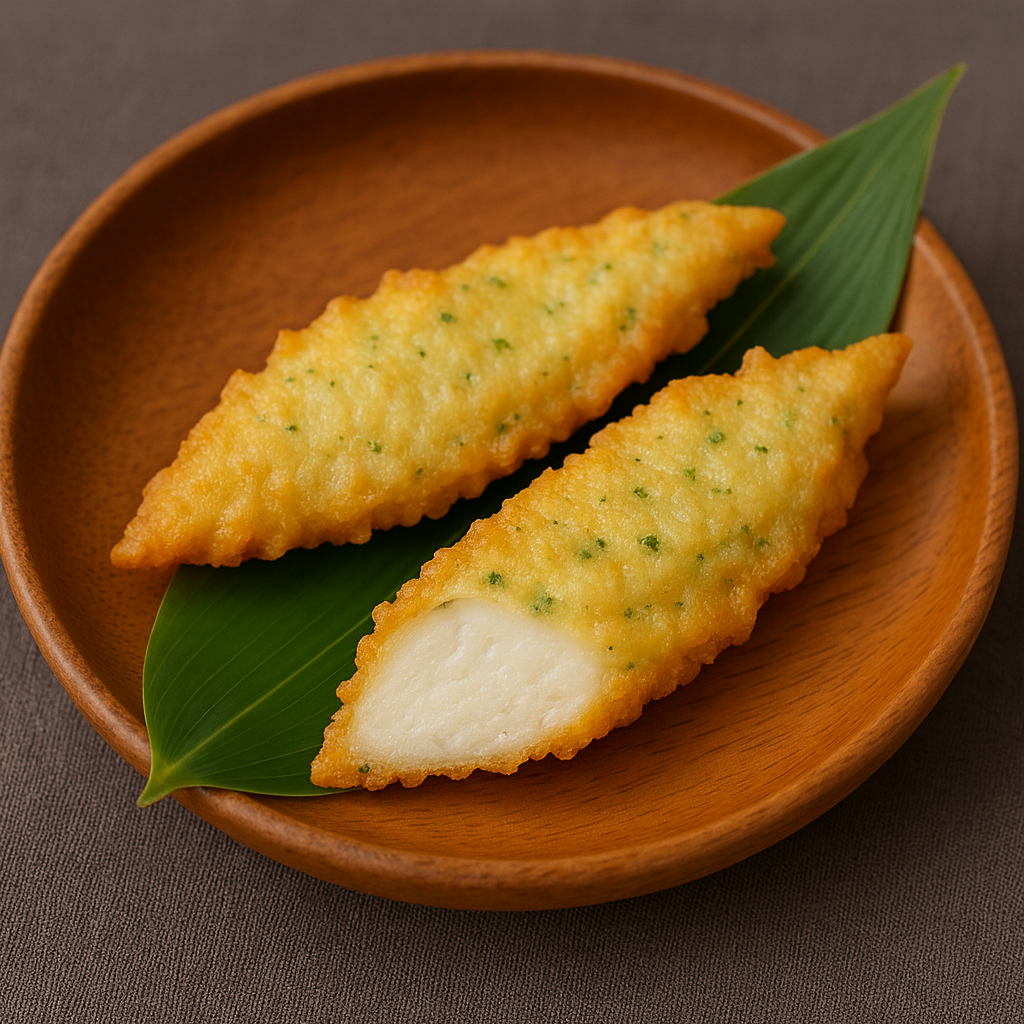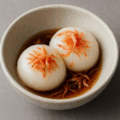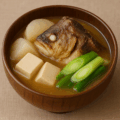笹かまぼこの磯部揚げ(宮城)の特徴
笹かまの旨みを、青のり香る衣で包んでカリッと仕上げます
宮城名物の笹かまぼこを青のり入りの衣でさっと揚げると、外は香ばしく中はぷりっとした食感が際立ちます。下味は控えめにして、笹かま自体の魚の旨みを生かします。
おつまみ・おやつ・行事の一皿として幅広く親しまれています
そのままでも美味しい笹かまを手早くアレンジでき、レモンや大根おろし、しょうがなどを添えると後味がさっぱりします。青のり衣のほか、焼き海苔で巻いて揚げる作り方もあります。
笹かまぼこの磯部揚げ(宮城) レシピ
材料(5人分・10枚分目安)
- 笹かまぼこ … 10枚
- 薄力粉 … 大さじ4
- 片栗粉 … 大さじ2
- 青のり … 大さじ1〜2
- 冷水 … 120〜150ml(衣の濃度で加減)
- 塩 … ひとつまみ
- 揚げ油 … 適量
- (添え・任意)レモン・大根おろし・おろし生姜・七味 … 適量
作り方
- 笹かまは水気をふき、厚みがある場合は斜め半分に切る。
- 衣を作る:ボウルに薄力粉・片栗粉・塩・青のりを入れ、冷水を少しずつ加えて軽く混ぜる(ややとろり)。
- 油を170〜180℃に熱する。笹かまに衣を絡め、余分を落として静かに入れる。
- 片面1〜2分ずつ、薄く色づくまで揚げる。油をよく切る。
- 器に盛り、好みでレモンを搾る/大根おろし・生姜を添える。
シェフのワンポイントアドバイス
- 衣は混ぜすぎないほうが軽く揚がります。粉っぽさが消えたら止めます。
- 笹かまに含まれる水分でハネやすいので、表面はしっかりふき取ります。
- 青のりは仕上げにひとつまみ追い入れすると香りが立ちます。
栄養価(1人分の目安)
- エネルギー … 180〜260 kcal
- たんぱく質 … 9〜14 g(笹かま由来)
- 脂質 … 8〜14 g(揚げ油の吸油で変動)
- 炭水化物 … 12〜20 g(衣由来)
- 食物繊維・ミネラル … 青のり・海苔由来
歴史
笹かまの“手早い一工夫”として家庭と酒場に広がりました
焼き蒲鉾の産地・宮城では、そのままの笹かまにひと手間加える料理が親しまれてきました。衣に海藻を合わせる“磯部”の香りが、魚の旨みを引き立てます。
屋台や惣菜でも定番の味です
揚げ置きしても食感が保ちやすく、冷めても香りが良いため、行事や惣菜、酒肴としても定番になりました。家ごとの衣の濃度や海苔の使い分けが“我が家の味”です。
English Version
Features of Isobe-age Sasa Kamaboko (Miyagi)
Seal the fish cake’s umami in a crisp, aonori-scented batter
Lightly frying Miyagi’s sasa kamaboko (bamboo-leaf–shaped fish cake) in a batter flecked with green laver makes a crisp outside and bouncy inside. Keep seasoning minimal to let the fish flavor shine.
Beloved as a snack, side, or party platter
It’s a quick uplift to ready-to-eat fish cakes. Serve with lemon, grated daikon, or ginger for a clean finish. You can also wrap with toasted nori instead of mixing laver into the batter.
Recipe – Isobe-age Sasa Kamaboko (Miyagi)
Ingredients (Serves 5 • about 10 pieces)
- Sasa kamaboko … 10 pieces
- All-purpose (cake) flour … 4 Tbsp
- Potato starch … 2 Tbsp
- Aonori (green laver) … 1–2 Tbsp
- Ice-cold water … 120–150 ml (adjust for batter thickness)
- Salt … a pinch
- Neutral frying oil … as needed
- (Optional to serve) Lemon wedges / grated daikon / grated ginger / shichimi … as desired
Directions
- Pat the fish cakes dry. If very thick, slice diagonally in half.
- Make the batter: in a bowl combine flour, potato starch, salt, and aonori. Add ice-cold water gradually and mix lightly to a loose, slightly flowing batter.
- Heat oil to 170–180 °C. Coat fish cakes, let excess drip off, and slide into the oil.
- Fry 1–2 minutes per side until lightly colored and crisp. Drain well.
- Plate and finish with lemon, grated daikon, or ginger to taste.
Chef’s Tips
- Do not overmix the batter—stop when the dry spots disappear for a lighter crust.
- Moist fish cakes can sputter; dry surfaces thoroughly before battering.
- For extra aroma, sprinkle a pinch of aonori into the batter just before frying.
Nutrition (per serving, approx.)
- Energy … 180–260 kcal
- Protein … 9–14 g (from fish cake)
- Fat … 8–14 g (varies with oil uptake)
- Carbohydrates … 12–20 g (from batter)
- Dietary minerals & fiber … from seaweed
History
A quick “one tweak” to showcase Miyagi’s grilled fish cakes
In Miyagi, simple add-ons to ready-to-eat sasa kamaboko are popular. The seaweed-scented “isobe” crust amplifies the fish umami.
A staple for stalls and deli counters
It holds texture even after cooling, so it’s common at festivals, as deli fare, and with drinks. Batter thickness and seaweed choice differ by household—true “home style.”



何でも質問してください!